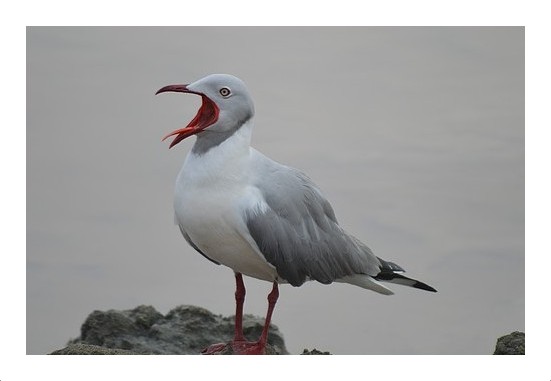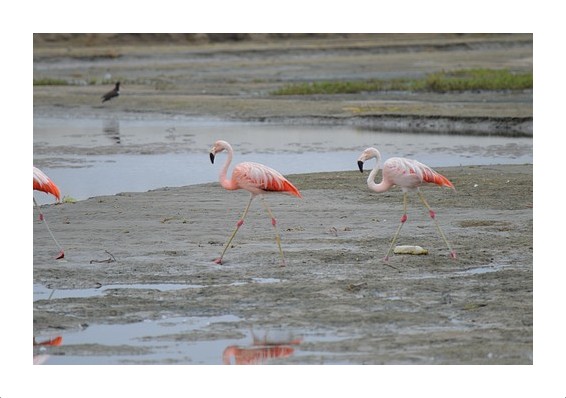The Peregrine Vol 17, No 1, January/February 2018
Additional Article
"Ruta del Sol" in Ecuador

Take the "Sun Route" to Enjoy Ecuador's Avian Wealth
When I think about my first birding trip to Ecuador, I conjure images of clouds of hummingbirds fluttering non-stop around sugar feeders in the Mindo cloud forest. Up to 28 species can be seen just by visiting lodges accessed via the "El Paseo del Quinde" or Hummingbird Trail, part of Ecuador's network of Ecorutas that emphasize sustainable nature tourism.
The birding in Mindo is sublime and easy, but with a few drawbacks — it rains almost every day, and sunshine is a rarity. So when my husband Steve and I planned a return visit to Ecuador, we decided to explore another part of the "Ecoruta," one that promised cerulean skies and sun-drenched landscapes. Though less known to birders, the "Ruta del Sol" or Sun Route stretching from Guayaquil northward along the Pacific Ocean, offers hundreds of species of birds, including Tumbesian endemics (birds confined to Southwestern Ecuador and northwestern Peru). The fascinating journey passes through picturesque fishing villages and miles of pristine beaches, and a variety of habitats from coastal scrub and salt lagoons to lowland semi-humid deciduous woodlands and, yes, even cloud forests.
We flew into Guayaquil, the largest and most populated city in Ecuador, the country's main port of entry. Often called the "Pacific Pearl," Guayaquil offers numerous historical sights, museums and parks, and for birders, a number of fine birding spots less than an hour from the city. A cadre of endemics can be seen at the Cerro Blanco Protected Forest, just 45 minutes outside Guayaquil, one of the few remaining areas of dry tropical forest in all of Ecuador. We made two visits to Cerro Blanco — a half-day afternoon orientation tour with a private guide, Eric Priess, who also arranged for our return visit the following day on our own. Boasting 211 avian species, Cerro Blanco offers 15 kilometers of easy walking trails, a visitor center, rehabilitation center, tree nursery, and picnic areas.
Our late-afternoon visit was timed perfectly, as the birds were just starting to move around after a post-lunch nap. Shortly after entering the park, we got our first endemics of the trip - a flock of Pacific Parrotlets, a couple of Gray-cheeked Parakeets, and an Ecuadorian Piculet, all foraging in a fruiting tree. More endemic sightings followed with an hour-long walk along the lush Buenavista Trail where we were rewarded with close-up looks at a Red-billed Scythebill and a Plain Antvireo, as well as a fleeting glimpse of a pair of Superciliated Wrens scampering through the dense undergrowth. In a ficus tree, Eric pointed out a Streaked Saltator singing a melodic "tchew-tchew-tcheeer" and then another endemic, a Sooty Crowned Flycatcher perched in a snag.
Winding down to an open picnic area with restrooms, educational signboards, an amphitheater, and a small water feature, we relaxed under a shady gazebo and spotted two more endemics. We thrilled at a pair of Scarlet-backed Woodpeckers, showing off their gorgeous wine-red upperparts, and had close-up views of a quiescent Ecuadorian Trogon, a large trogon with a red belly. As we sat, a Vermillion Flycatcher, oblivious to our presence, showed us its superb hunting technique and in the nearby woods, we counted a half-dozen White-tailed Jays congregating in the treetops. These large endemic jays are dark blue above with a white chest and mostly white tail, and they call noisily to one another as they cartwheel through the canopy.
The next morning we visited the Manglares Churute Reserve to see Horned Screamers, about 45 minutes' drive from Guayaquil. We booked a day tour again with Eric, who took us to a remote marshy area dominated by rice paddies where gooselike screamers were known to hang out. We walked a muddy trail along the paddies and could see a half dozen of the birds in a distant field at the trail's end. As we approached the screamers, Eric pointed out other lifers for us in the wetlands and surrounding forest, including endemic Pacific Horneros, Savanna, Gray and Variable Hawk, Gray-Breasted Martins, and Peruvian Meadowlarks. Even Eric got excited when a rare Comb Duck wandered over the marsh, unmistakable by its large size, white underparts, and glossy green and purple wings.
After getting some nice photos of the screamers, Eric drove us to a lush forest trail in the reserve, where we watched an endemic Pacific Royal Flycatcher construct a nest and spotted a West Peruvian Pigmy Owl snoozing in dense foliage. Ecuadorian Thrushes, another endemic, were everywhere, foraging through leaf litter while a pair of Jet Antbirds bounced from branch to branch a couple of feet from the trail. On the drive back to Guayaquil, we stopped along the road for close-up views of a Northern Crested Caracara feasting on carrion, and got one last look at a group of Horned Screamers in an overgrown field.
The popular seaside resort of Salinas is also a birding hotspot, easily reached via a pleasant two-hour drive from Guayaquil. Bathed by the Pacific Ocean and boasting powdery sand beaches and aquamarine waters, it's a favorite family vacation spot offering countless water sports and a seaside boardwalk with amusements and entertainment day and night. As a corridor for migratory birds, there are three excellent birding spots to explore: the Ecuasal Salt Lagoons, La Libertad, and La Choclatera. To reach Ecuasal, simply follow the coastal road south along the Malecon leading out of town, and look for the entrance gate to the salt plant. Drive through the gate to the parking area outside the main office and inquire inside whether there are any guides available to accompany you in your car to see the birds. You can lose your way through the vast maze of lagoons, so a guide is essential to navigate through these rich avian feeding grounds. Our guide spoke no English, but nonetheless guided us for about three hours, signaling left or right turns, as we watched Chilean Flamingos, Peruvian Pelicans, and White-cheeked Pintails feeding and bathing. A host of shorebirds and ducks also vied for our attention including Royal, Elegant, and Sandwich Terns, Blue-winged Teal, Black-necked Stilts, and Gray-hooded Gulls. If the salt plant is closed, you can bird the lagoons on your own from the roadside, and scan the beach across the street for Surfbirds, Laughing and Franklin's Gulls, Wilson's Plovers, and American Golden-Plovers.

Also a short distance from the Malecon and located inside a military compound, La Libertad and La Choclatera offer miles of walking trails winding through coastal scrub. We spent an entire morning searching through the xerophytic vegetation where we found Ecuadorian and Croaking Ground Doves, Fasciated Wrens, Long-Tailed Mockingbirds, and Tropical Gnatcatchers. Amazilia Hummingbirds were numerous and easy to spot, buzzing from flower to flower like bees, but the star attraction was a Laughing Falcon perched in a low snag taking a mid-morning nap.
That afternoon, we strolled the neighborhood of our hotel and enjoyed the antics of Red-masked Parakeets, another endemic. You can find these gregarious birds feeding on fruiting trees throughout town in small groups of up to 20 individuals. They are unmistakable by their bright red head, and we even found a pair going in and out of a makeshift cavity in the roof of a house a block from our hotel.
The drive north from Salinas along the Ruta offers endless opportunities for sailing, surfing, fishing, diving, and whale watching, and good accommodations can be found in Montanita, La Entrada, Puerto Rico and Puerto Lopez. A popular birding spot, the Machalilla National Park occupies 136,000 acres comprising beaches, tropical humid and dry tropical forest, cloud forest, and two islands, Isla de la Plata and Salango. It's about a three-hour drive to Machalilla from Salinas, but a nice variety of habitats will keep you busy for a few days.
One of the main attractions of Machalilla is a boat excursion to the "Isla de la Plate," a.k.a. "The Poor Man's Galapagos." Located 15 miles off the coast, the isla has an ecosystem similar to the Galapagos and is home to Blue-footed, Nazca, and Red-footed Boobies, Magnificent Frigatebirds, Red-billed Tropicbirds, and other species. A number of tour companies make the 90-minute trip daily from the bustling fishing town of Puerto Lopez, taking passengers on a two-hour hike across the island. You can't beat the $30 price tag, which includes the tour, a snack, snorkeling gear (optional) and park admission. If you need a trio of boobies for your life list and can't afford the Galapagos, the isla is the next best thing.
Another popular attraction is the village of Agua Blanca, about ten minutes north of Puerto Lopez. In addition to archaeological sites, a museum and walking trails, the indigenous people who reside here offer guided tours for a small fee. You can bird the area on your own, as well, as we did, to look for Blue-crowned Motmot (Ecuadorian race), White-tipped and Eared Doves, Social Flycatchers, and One-colored Becards, to name a few.
One of the most reliable places to find the rare endemic Esmeraldas Woodstar is located south of Machalilla in the Ayampe river valley. The Rio Ayampe is the only river with fresh water in the area that is collected and transported by trucks to the nearby villages. At the time of our visit, the river was completely dried up as a result of a long drought, and the birding was challenging, but we couldn't resist the chance to see the tiny (2 1/2 inch) Woodstar with its pinkish-violet gorget and forked tail. Unfortunately, it was not to be, but we did find some interesting birds in the lush hillsides along the parched river bed including Masked Water Tyrants and Great Antshrikes.
Finally, one of Ecuador's last remaining semi-dry tropical forests can be explored at Pacoche Lodge, about 45 minutes north of Puerto Lopez. Covering 10 hectares, you can walk a series of trails that wind through thick forest, or you can relax in the restaurant and watch saltators, tanagers, woodpeckers, and other species that visit the fruit feeders. We stayed in Manta, about a half hour's drive from Pacoche and made day trips to the reserve, but two rustic cabins are available for birders who want a true jungle experience.
We flew back home from Manta via Quito and had a day-long layover near the new Quito Airport. The weather was cool, rainy, and windy and reminded me of just why the "Ruta del Sol" enticed me like a bowl of butter pecan ice cream on a hot summer day. And our trip tally of 120 birds with 36 lifers turned out to be the cherry on the top!
* * * * * * * * * * * * * * * * * * * * * *
If a Galapagos trip is in your future, and you're flying there from Guayaquil, consider a pre- or post-extension birding trip on the Ruta del Sol. It's a worthwhile and affordable adventure you won't soon forget.





